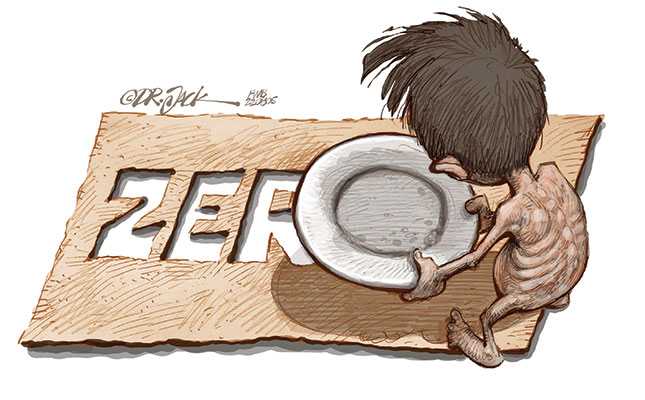
Despite hopes that the world would emerge from the COVID-19 pandemic in 2021 and food security would begin to improve, the level of world hunger rose further last year.
After remaining relatively unchanged since 2015, the prevalence of undernourishment (PoU) jumped from 8% in 2019 to 9,3% in 2020, and then to 9,8% in 2021. It is estimated that between 702 million and 828 million people were affected by hunger last year.
That number has grown by around 150 million since the outbreak of the COVID-19 pandemic (103 million more people between 2019 and 2020, and 46 million more in 2021).
The further increase in global hunger in 2021 reflects exacerbated inequalities across and within countries due to an unequal pattern of economic recovery, and the unrecovered income losses among those most affected by the COVID-19 pandemic.
In 2021, hunger affected 278 million people (20,2% of the population) in Africa, 425 million (9,1%) in Asia, and 56,5 million (8,6%) in Latin America and the Caribbean (LAC).
While most of the world’s undernourished people live in Asia, Africa is the region where the prevalence is highest. After increasing between 2019 and 2020 in most of Africa, Asia and LAC, hunger continued to rise in most subregions in 2021, but at a slower pace. Compared with 2019, the largest increase was observed in Africa, both in terms of percentage and number of people.
It is estimated that nearly 670 million people, or 8% of the world’s population, will still be undernourished in 2030, which is the same percentage as that in 2015 when the UN’s 2030 Agenda was launched.
After increasing sharply in 2020, the global prevalence of moderate or severe food insecurity remained mostly unchanged in 2021, whereas that of severe food insecurity increased, providing additional evidence of a deteriorating situation mainly for people already facing serious hardships.
Around 2,3 billion people, or nearly 30% of the world’s population, were moderately or severely food-insecure in 2021, up by more than 350 million from 2019, the year before the COVID-19 pandemic unfolded.
The prevalence of severe food insecurity increased from 9,3% in 2019 to 11,7% in 2021, the equivalent of 207 million more people in two years.
Scenario in Africa
In Africa, 35 million more people were affected by hunger in 2020 than in 2019, before the outbreak of the pandemic, with an additional 15 million in 2021, for a total of 50 million more people in two years.
Similarly, nine million more people were affected by hunger in LAC in 2020 than in 2019, and an extra four million were thrust into hunger between 2020 and 2021. In Asia, increases of 58 million and 26 million people were seen in 2020 and 2021 respectively.
Looking more closely at differences at the subregional level, the proportion of the population affected by hunger in North Africa in 2021 (6,9%) was much smaller than in almost all subregions of sub-Saharan Africa, and somewhat smaller compared with Southern Africa (9,2%).
In the other subregions on the continent, the PoU in 2021 ranged from 13,9% in West Africa to 32,8% in Central Africa. Following increases in hunger in all subregions in 2020, most showed further increases in 2021.
The PoU increased by more than two percentage points in Central Africa two years in a row. In East Africa, the PoU jumped 2,7 percentage points in 2020, but remained relatively stable in 2021. Both Southern and West Africa experienced smaller increases in PoU from 2020 to 2021 compared with the previous year, reflecting the lingering effects of the pandemic.
Zero hunger?
The prospects for achieving ‘Zero Hunger’ by 2030 are disheartening. The Food and Agriculture Organization of the United Nations’ ‘State of food security and nutrition in the world 2021’ report already presented a discouraging projection of how many people might be affected by hunger in 2030.
This estimate was based on the extrapolation of recent trends in the three fundamental variables used to compute the PoU for each country: the total supply of food; the size and composition of the population, which determine the total dietary energy requirements; and the degree of inequality in terms of access to food within the population.
The conjecture that hunger would begin to decline as early as 2021, driven by the expected economic recovery after COVID- 19, did not come to pass. As discussed here, the lasting impact of the pandemic, and the consequent increase in inequality, prevented this expectation from coming to fruition.
Instead, it is now forecast that nearly 670 million people will still be undernourished by 2030. This amounts to 78 million more undernourished people in 2030 compared with a scenario in which the pandemic did not occur.
Russia-Ukraine war
At the time of writing this report, another ongoing crisis was expected to affect the trajectory of the world’s food security: the Russia-Ukraine conflict.
Russian and Ukraine are prominent players in the global trade of food and other agricultural products, in particular that of wheat, maize, sunflower seed and oil, as well as fertilisers, in markets characterised by exportable supplies concentrated in a handful of countries.
This concentration makes these markets especially vulnerable to shocks such as that which the Russia-Ukraine war represents.
Several risks emanating from the conflict will directly and indirectly affect global supply. Disruptions in trade flows and the resulting risk of soaring prices are among the first of these to consider. In addition, the potential risk of reduced production levels and logistical risks, such as those posed by the damage to transport, storage and processing infrastructure, must also be examined.
When all of these are taken into account, they cast a shadow on the prospect of food insecurity in the short and medium term, especially in impoverished countries. They also constitute a barrier to achieving the UN’s Sustainable Development Goal of Zero Hunger.
However, while the unfolding crisis in Ukraine adds additional uncertainty to the projections of global hunger levels in 2030, it is still premature to try and quantify the impact of the conflict, given the many different ways in which it could affect global food insecurity.
The views expressed in our weekly opinion piece do not necessarily reflect those of Farmer’s Weekly.
This is an edited excerpt of a Food and Agriculture Organization of the United Nations report titled ‘The state of food security and nutrition in the world 2022.’










